TSUKUBA FUTURE
#032 Cultural Properties, to the Rescue! Protecting Objects of Universal Value through Science
Associate Professor MATSUI Toshiya, Faculty of Art and Design

Objects of art, handicrafts, Buddhist statues, implements used in daily life?cultural properties such as these, collected from all over the world, are displayed in museums and art museums for easy viewing and appreciation. Objects kept in indoor environments are also affected by changes in lighting and humidity, as well as vibrations caused by the viewers themselves, and they deteriorate little by little.
Stone statues or structures open to the elements are even more readily affected. Obvious causes of erosion include rain and wind. And although moss and lichens may create a special ambience, as organisms that live in symbiosis with fungi and algae they are in fact potent enemies of cultural properties.
Yet scrubbing is off the table as a cleaning method. Nor can one afford to wait until something becomes spoiled or ruined to mend it; by then it is already too late. One must identify the many causes of stress to the cultural property, taking into consideration past restoration work performed, the climate, how the object is displayed, and other factors, before scientifically determining the best course of action for preservation or restoration. These processes are what conservation science is all about. Prof. Matsui's own conservation policy is to maintain the cultural property in as close to its original condition as possible, causing the least amount of disturbance.
Research on cultural properties was once the exclusive domain of historians and archaeologists. There was a tendency to invoke science only when materials needed to be analyzed or x-ray images taken. But long-term preservation methods must be employed when objects that are considered public assets are to be displayed or otherwise maintained.
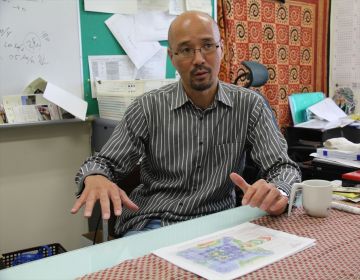
Using vibration gauges at the ruins of Angkor Wat, Prof. Matsui studied the effects of tourists on the structure. The document on his desk is a graph showing the detected vibrations plotted against the layout of the ruins.
That requires analysis of the physical deterioration and a scientific understanding of its causes. Care must also be taken with restorations. If high-tech materials are used to provide weather resistance in a harsh environment, the areas where the materials are specifically applied may become more weather-resistant, but long-accumulated stresses will sometimes shift to another area and the damage will spread. To relieve subsequent stresses, the high-tech material used for the earlier repair must first be broken up in a way that does not affect the original material. For such reasons, conservation experts use a "weak" repair material. At other times an indirect method will be used instead to stop deterioration, such as changing the route taken by lines of visitors, or adjusting air conditioning settings.
The deterioration of cultural properties is not always due to aging, either. Prof. Matsui became engaged in an effort to rescue cultural properties from tsunami damage in the Great East Japan Earthquake in 2011. At the Whale and Marine Science Museum in the town of Yamada, Iwate Prefecture, a large number of items were damaged in the tsunami—from whale skeletons to diving apparatus, harpoon guns, even the account book of a medieval-period merchant. The museum had been flooded and the objects sullied by seawater mixed with the natural and artificial flotsam of an entire town. To clean the objects and prepare the museum for reopening, Prof. Matsui has been working with students and visiting the locale on a regular basis. Many of the objects on display were originally used in the sea, so they had been stored in a condition that had already been affected by seawater to some degree before the tsunami. Such items should not be washed mindlessly. To restore them to their pre-disaster condition, Prof. Matsui analyzes reference materials and has established the practice of only removing soiling clearly caused by the tsunami. His goal is to restore the objects to a condition that can once again stably withstand display at the museum.
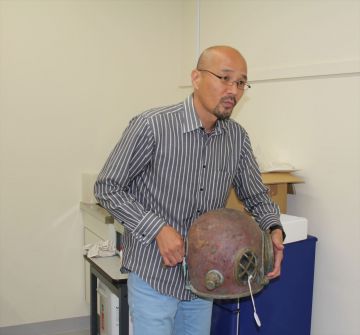
Diving apparatus at the Whale and Marine Science Museum damaged by the tsunami.
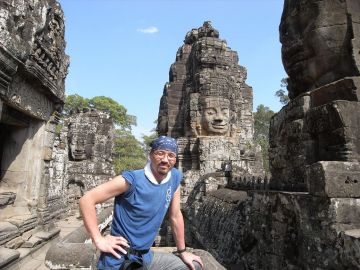
Prof. Matsui is well-traveled to World Heritage Sites; here, at Angkor Wat.
Prof. Matsui discovered conservation science as a graduate student. He had been working in a research lab in the field of fine and applied chemistry when the lab was asked to analyze x-ray images from the Nara National Research Institute for Cultural Properties; he happened to be assigned to the task. While working on research related to the corrosion of iron and attempting to develop a non-rusting material, Prof. Matsui took an interest in the rust (iron oxide) on a sword discovered in a layer of earth from ancient times that had remained completely intact. His interest shifted from "why it was still intact" to "how it could be preserved." After completing his graduate studies, he began anew to pursue that line of study.
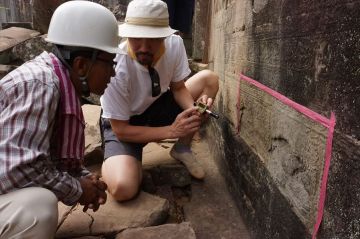
At Angkor Wat; performing a stone degradation assessment with a local restoration expert.
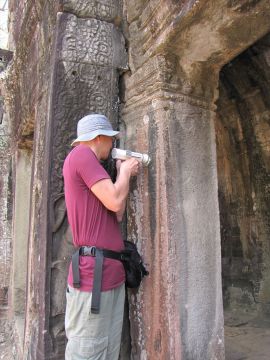
Carefully checking for living organisms adhering to the surface of the ruins.
Prof. Matsui travels frequently to locations where cultural properties are found, from World Heritage sites to small-town museums and temples. In addition to his work in Yamada, he has spent time at the Tomioka Silk Mill in Gunma Prefecture, Angkor Wat in Cambodia, and the Nazca Lines of Peru?flying all over the world. He welcomes students in his department, as well as students from other departments, to join him at on-site projects if they are interested.
However, the protection of cultural properties entails more than preservation and restoration techniques. It demands collaboration with local people and the expertise of specialists in many fields?archaeology, history, art, architecture, analysis, materials, microorganisms, and beyond. For the students, these trips are a valuable opportunity to gain experience in real-world cultural property conservation and see how the discipline connects directly to society.
"Cultural properties belong to all of us. No matter the object, no matter what period in history it comes from, as long as someone is interested in protecting it, we support its preservation in compliance with their wishes." That is Prof. Matsui's philosophy. He expresses no preference for any particular type of cultural property or material, instead handling everything from bricks and ancient manuscripts to stone Buddhist images, pottery, reliefs, wooden ships, samurai residences, and so on. He is constantly developing new preservation methods and materials for performing repairs. Within the scope of conservation science, Prof. Matsui comes into contact with many kinds of people and cultural properties, and he continues to expand the breadth of his research.
Article by Science Communicator at the Office of Public Relations


